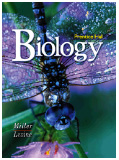BIOLOGY
by Miller & Levine
[complete Table of Contents]

|
Use the pull-down menu to jump to any of the Book's 40 Chapters: |
Additional Resources:
![]() Chapter 36
Chapter 36 ![]()
SKELETAL, MUSCULAR, AND INTEGUMENTARY SYSTEMS
In this chapter, students will read about the structure and function of the skeletal, muscular, and integumentary systems of the human body. The links below lead to additional resources to help you with this chapter. These include Hot Links to Web sites related to the topics in this chapter, the Take It to the Net activities referred to in your textbook, a Self-Test you can use to test your knowledge of this chapter, and Teaching Links that instructors may find useful for their students.
| Hot Links | |
| Take it to the Net | Teaching Links |
What are Web Codes? |
Web
Codes for Chapter 36: |
![]()
Section 36-1: The
Skeletal System
![]() The human skeleton
supports the body, protects internal organs, provides for movement, stores
mineral reserves, and provides a site for blood cell formation.
The human skeleton
supports the body, protects internal organs, provides for movement, stores
mineral reserves, and provides a site for blood cell formation.
![]() Bones are a solid
network of living cells and protein fibers that are surrounded by deposits
of calcium salts.
Bones are a solid
network of living cells and protein fibers that are surrounded by deposits
of calcium salts.
![]() Depending on its
type of movement, a joint is classified immovable, slightly movable, or
freely movable.
Depending on its
type of movement, a joint is classified immovable, slightly movable, or
freely movable.
Section 36-2: The
Muscular System
![]() There are three
different types of muscle tissue: skeletal muscle, smooth muscle, and
cardiac muscle.
There are three
different types of muscle tissue: skeletal muscle, smooth muscle, and
cardiac muscle.
![]() A muscle fiber
contracts when the thin filaments in the muscle fiber slide over the thick
filaments.
A muscle fiber
contracts when the thin filaments in the muscle fiber slide over the thick
filaments.
![]() The energy for
muscle contraction is supplied by ATP.
The energy for
muscle contraction is supplied by ATP.
Section 36-3: The
Integumentary System
![]() The integumentary
system serves as a barrier against infection and injury, helps to regulate
body temperature, removes waste products from the body, and provides protection
against ultraviolet radiation from the sun.
The integumentary
system serves as a barrier against infection and injury, helps to regulate
body temperature, removes waste products from the body, and provides protection
against ultraviolet radiation from the sun.